- What is a Gaited Horse - October 5, 2023
- What to Look at When Getting a New Farrier - September 21, 2023
- Best Horse Feeds for Older Horses - September 21, 2023
While I had ridden horses as a child, I never gave the saddles I used much thought. Truthfully, we often rode without a saddle. Fast forward a few decades, and as an adult, I wanted my four-year-old also to start riding. To my amazement, some saddles fit different ponies and different types of riding.
A saddle is not just a piece of leather-strapped to the horse’s back!
So when the instructor said my son was ready to lease his pony but that I had to buy a saddle for him, I was utterly lost. Standing at the saddlery, gazing at the walls of pretty saddles with decorations, strange shapes, more bling than a Madonna concert, and odd shapes that I couldn’t even believe a saddle could have—I turned into a goldfish.
With my mouth opening and closing dumbly, I stared at the riding equipment, desperate for some good advice on what type of horse saddle would be best for my child. Fortunately, the shop owner was an experienced horse lady, and she kindly gave me a crash course on horse riding, equipment, and saddles.
Almost two decades later, my son is now a real equestrian, and I’ve become quite the expert on saddle types too. When I explain to people about different types of saddles for horse riding, I always remember the advice I got from that very Southern horse lady years before: “A saddle is like a horse’s bikini. No matter the style of the saddle, if it doesn’t fit right, it won’t work well or look good.”
Background and History of Horse Saddle Types

The first horse saddle was invented in 800 BCE by the Sarmatians. Horses had previously been used as pack animals only. When people started riding them, riding was mostly done bareback. However, with the creation of heavier weapons during the war, mounted warriors began to prove very effective during battle.
A soldier on a horse is a very powerful weapon, but because soldiers struggled to stay on the horse, a saddle was invented. The first saddles didn’t have any stirrups. Riders had to brace their legs against their horses’ sides. However, with the invention of armor, the need for stirrups also became apparent. Stirrups were invented as early as 300 CE.
The first instance of stirrups was recorded in India, where L-shaped bars appeared, attached to the sides of the saddle to help riders balance and stay mounted during combat. However, there is also evidence of saddles with stirrups from China around the same time as the invention of the saddle itself.
The first saddles had an ungainly frame that didn’t do the horses much kindness, and it certainly wasn’t kind to riders either. Over time, the modern saddle tree was designed, and from there, working saddles evolved.
Over the years, the saddle types changed according to the riders’ needs. As horses became more involved in ranch work, the Western saddle was invented. It was based on the Spanish vaqueros’ saddles, with the addition of a saddle horn to help tie up steers when needed.
Military saddles also evolved. The traditional army saddle with its wooden raised frame soon changed to the English saddle as we know it today. Different types of saddles also influenced other parts of the world.
Australian cowboys invented a saddle known as a stockman saddle, with leather cups to help secure the rider’s thighs during gallops across rough country. We all remember the epic ride of the Man from Snowy River where the cowboy rode down a steep cliffside due to being able to grip with these leather cups. The stockman later evolved into the modern polocrosse saddle.
With endurance riding becoming a popular sport, other saddle types evolved, including the modern-day McLellan saddle, characterized by the elongated hole in the middle of the saddle. This saddle had further applications with cavalry units worldwide using this saddle on the battlefield and some modern mounted police officers riding in this model saddle across the world.
Saddles continue to evolve, with new technology influencing design and fit. Equestrian sport has contributed to the development of many different types of horse saddles that meet the requirements of dressage, eventing, showjumping, racing, endurance, and Western riding too.
Whatever your horse’s shape and your need, there’s a saddle out there to fit you both.
What Are Horse Saddles?
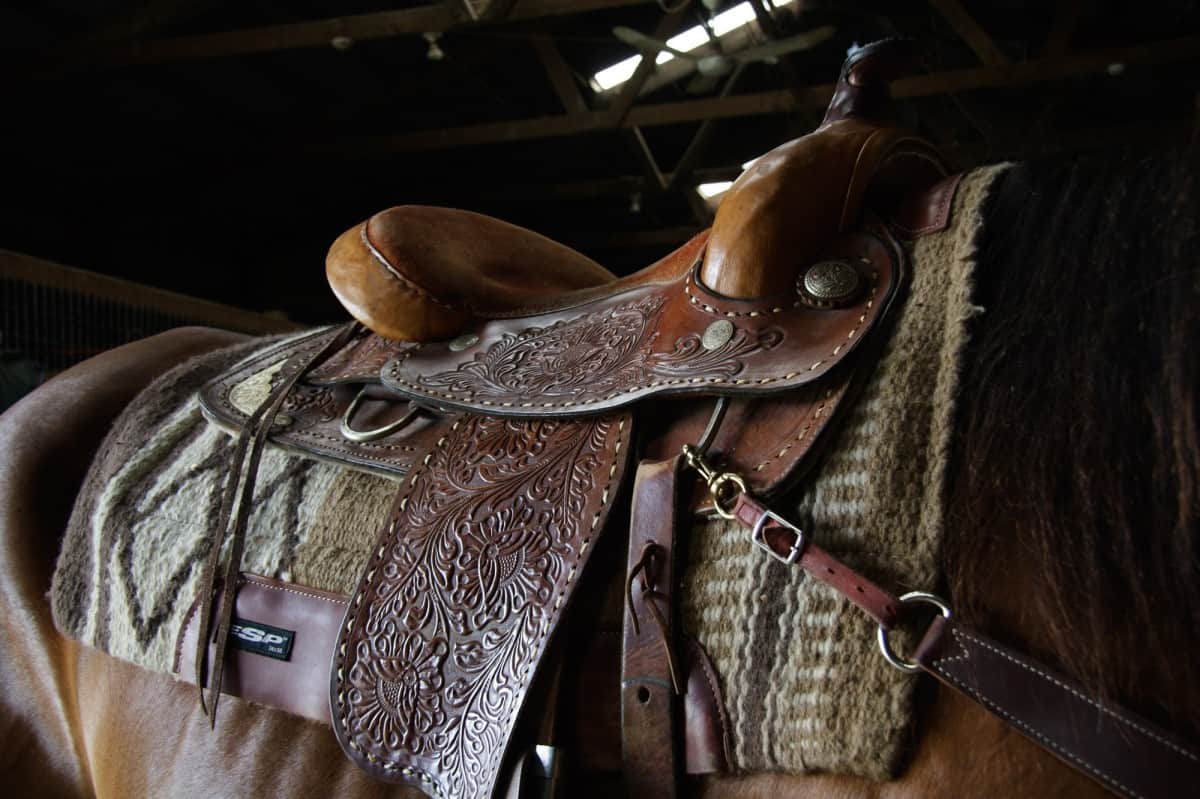
Horse saddles are pieces of equestrian equipment that are strapped to the horse’s back with a strap called a girth or cinch. The saddle has two leather straps on the sides known as stirrup leathers, to which there is a metal or leather loop in which the rider rests their feet.
While this may sound like a simplistic explanation of what a saddle is, whether your saddle is used for work, leisure, sport, or competition, all saddles follow this basic setup.
Saddle Accessories and Accompaniment
Saddles don’t just come as a leather bit that straps to the horse. A good saddle will have different parts that are changed according to the horse’s needs. Different lengths of girth will allow a saddle to fit a smaller or fatter horse.
English saddles are often adjustable, with a metal bar at the front part or pommel of the saddle to let the tree open or close to fit the unique shape of the horse’s shoulders better. Western saddles may not have adjustable trees, but different supports to the Western saddle change the saddle’s shape on the horse’s back.
A saddle also requires a saddle blanket, saddle pad, or numnah. The saddle pad helps prevent the saddle from slipping, it keeps the saddle clean, and in some cases, it helps a saddle fit better. Western saddles also feature fenders, which are leather flaps to protect the rider’s legs. These are removable, and different fenders serve different purposes.
When riders feel like they are slipping around on their saddle, they may also choose a bumna, a fluffy or sticky covering that helps improve the rider’s grip when seated on the saddle. The bumna pulls over the saddle seat, providing cushioning while also assisting the rider in not slipping around.
In addition to a bumna, which helps a rider not slip, there are also different pads to help a saddle remain balanced or improve the saddle fit. Riser pads are designed to help balance a saddle. These are compressed foam or gel pads that are thickened on one or both ends of the pad, lifting the saddle or helping to keep the saddle tree off the horse’s spine.
If your horse has a problem with the way they are built or their conformation, they may require intervention to have their saddle fit them. High withers, lack of withers, barrel shape, and flatbacks require some assistance to ensure the saddle fits correctly.
When riding a horse with an incorrect saddle type, the damage caused can ruin your horse’s back and make them unhappy with being ridden.
Common Problems and Solutions With Horse Saddles
When purchasing your horse’s first saddle, it can be quite overwhelming. Saddles aren’t cheap. When purchasing a saddle, you may find that the salespeople can either be knowledgeable or terrible.
Saddles are often non-refundable, and if your saddle doesn’t fit you or the horse, you will have to sell it at a loss and look for a different saddle. Some common saddle issues can make the buying process complicated, but I’ve got some great advice and solutions to that here:
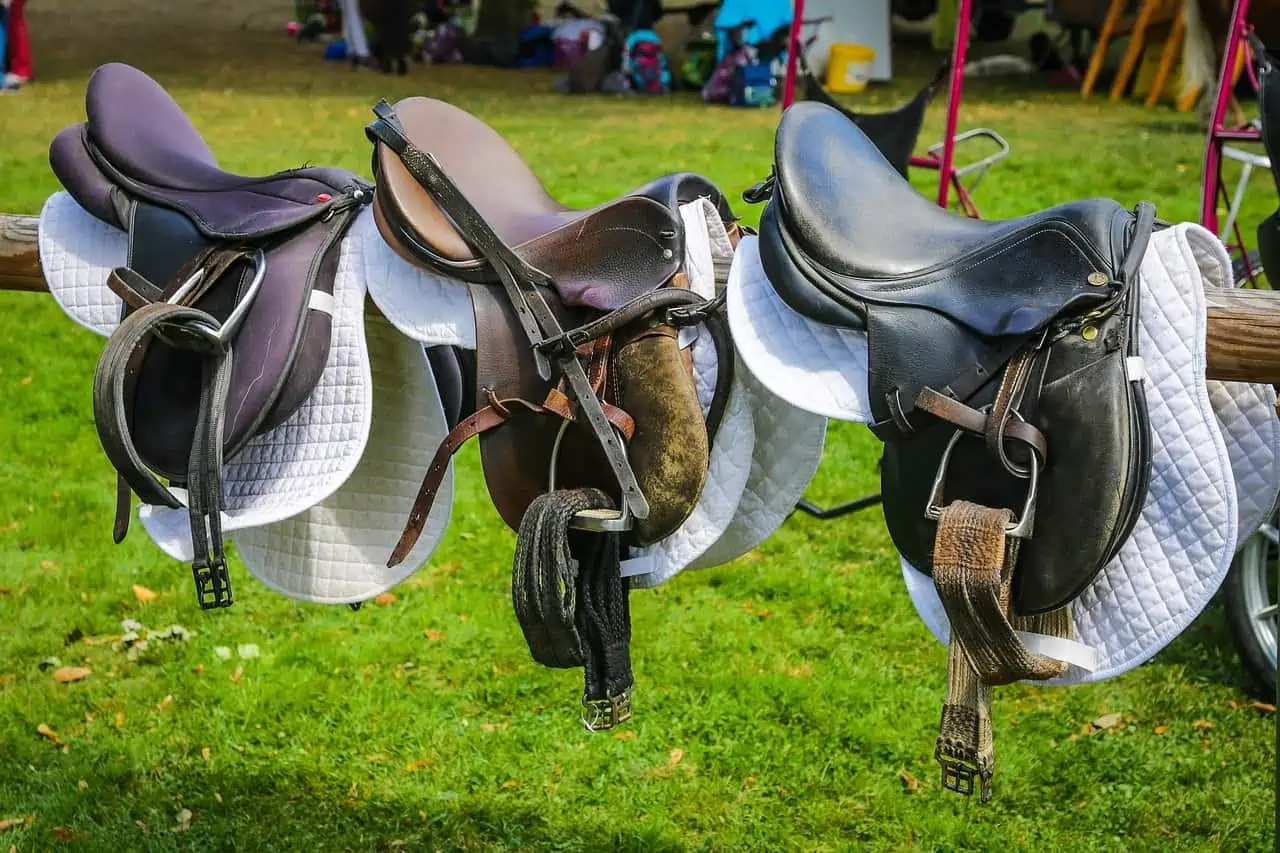
Saddles for High Withered Horses
Some horses have a very high wither. This is when the area of bone at the top of the horse’s shoulders (on their spine) sticks out more than with other horses. Finding a perfect saddle for such a horse can be a real challenge.
When you know your horse has a high wither, take a photo of their wither and back and take it to the shop where you intend to buy a saddle. A high wither will influence the type of gullet your saddle needs. With Western saddles, it may affect the pommel and horn structure.
Should you already have a saddle that pinches the horse’s wither, and you don’t want to sell it, you can try adding a front riser pad for an English saddle. This compressed foam insert will lift the saddle, so your horse’s spine is cleared in the front. These inserts come in different thicknesses.
Saddles for Chunky Monkeys
Perhaps your horse or pony is a “chunky monkey?” More accurately, it is a horse with a very round barrel, and almost no wither that sticks out. While this type of horse is a joy since they are usually “easy keepers” in terms of feeding, it can be a problem to fit a saddle to them. Most saddles tend to slip around their barrel.
I’ve found that a barrel-backed horse needs a saddle with a wide tree, as they usually have large and developed shoulders too. I’ve also found a couple of treeless saddles that worked like a charm, but this would be for a balanced rider only as a beginner may slip to the side and dangle under their horse.
For extra security, a round-shaped horse needs a few additional saddle “parts” like a breastplate to stop the saddle from slipping at the front and a tail crupper to secure the saddle at the back to the horse’s dock. These two additions will also stop the saddle from slipping forward or backward when trail riding and going up and down rough terrain.
Measuring a Saddle Successfully for the Rider
Most beginner riders think that a saddle size (usually given in inches) refers to the size of your (uhm) butt. It is not true. While a larger saddle may be suitable for a fuller-figured rider, the size of the saddle links to the length of the rider’s thigh.
The size is measured from the pommel to the cantle at the back, and it has more to do with the length of your leg. If you are a shorter rider, you should ride in a smaller saddle, while taller people require a larger saddle to sit comfortably.
However, if you need a larger seat, don’t be scared of scaling up to a larger saddle. The only snag is that the saddle length increases too. An overly long saddle can be a problem for short-backed horses as the saddle can’t extend past the horse’s last floating ribs. A too-long saddle will create pain in the horse’s withers and press on their kidneys.
Measuring a Saddle for the Horse
To get some indication of your horse’s saddle requirements, you can use a saddle gauge, which is an adjustable plastic measuring tool. The tool opens and closes across the horse’s withers to show you what size tree your horse requires. These saddle gauges are usually not expensive, and a correct measurement can save you a fortune if you can avoid a poor saddle buy.
Alternatively, if you can trailer your horse and take them to the saddle shop, the shop assistants will usually be able to bring you an array of saddles to try on your horse until you find one that fits correctly.
If you can’t take your horse to the shop, the shop will sometimes come to you. You can book a professional saddle fitter to come out to your stable or ranch and fit your horse with a few saddles. These individuals are usually affiliated with a particular saddlery and can bring sample saddles with them. They allow you to fit these saddles, even riding a short distance in a few saddles to check the comfort and how your horse reacts to particular saddles.
Rough Guide to Common Saddle Issues

I’ve noticed there are a few common issues that saddles (whether Western or English or trail) have, and most have a few solutions that can help remedy a problem.
| Saddle Issue | Solution to Try |
| Bridging saddle (saddle only touches on four corners) | A sheepskin numnah may help equalize pressure if the bridging isn’t too severe. |
| Tight shoulders (saddle squeezes the withers) | Use a saddle gullet guide to determine the right size tree. Use a front riser pad to lift the saddle. |
| Saddle flattens onto the back at the cantle (unbalancing the rider) | A rear rising pad can help alleviate this issue. |
| Saddle slips forward | Using a front riser pad, the saddle can “cling” better. |
| Saddle slips backward | Use a breastplate to secure the saddle and prevent backward movement. |
| A saddle is supposed to be cleared over the horse’s spine, so use a combination riser pad or a full sheepskin numnah to help lift the saddle. |
Saddle Fitting Checklist
Whenever I have to help one of the newer riders at the yard where my son’s horses are, I have the following checklist to tell whether their saddles are fitting correctly:
Shoulder Clearance
A well-fitting saddle should allow you to pass your hand between the saddle flaps and the horse’s shoulder (when the saddle isn’t girthed or cinched up yet). If you feel a pressure point on your hand, take a remedial measure, such as adding a half-sized sheepskin numnah to alleviate pressure.
Spine Clearance and Bridging Check
If you look down the saddle’s gullet channel (the tunnel you can see through to the front of the saddle to the cantle at the back) when standing at the back of the horse, do you see the saddle touching the horse’s spine? Only treeless saddles can “touch” a horse’s spine. Any treed saddle needs to be well clear of the horse’s spine.
There should also not be touchpoints along the sides of the horse’s spine where the saddle applies more pressure and doesn’t sit evenly on the horse’s back muscles.
Horizontal Saddle Seat
The saddle’s seat should be horizontal and parallel to the ground when seen from the side. If the saddle seat tilts upward, it will throw the rider backward in the saddle. Should the rear end of the seat be tilted upward, the rider’s weight will press more on the horse’s shoulders.
Saddle Evenness
The saddle should sit evenly on the horse. I like to walk around the horse, examining it from all sides. If I notice the saddle fits unevenly at any point, perhaps leaning over more, or the cantle isn’t balanced at the back, there may be a conformation issue with the horse. Or the saddle tree may be twisted.
Twisted saddles often result when a horse falls with its saddle or rolls over its saddle. These twisted saddles are dangerous and shouldn’t be ridden in.
Best Tips to Choose a Type of Saddle for You
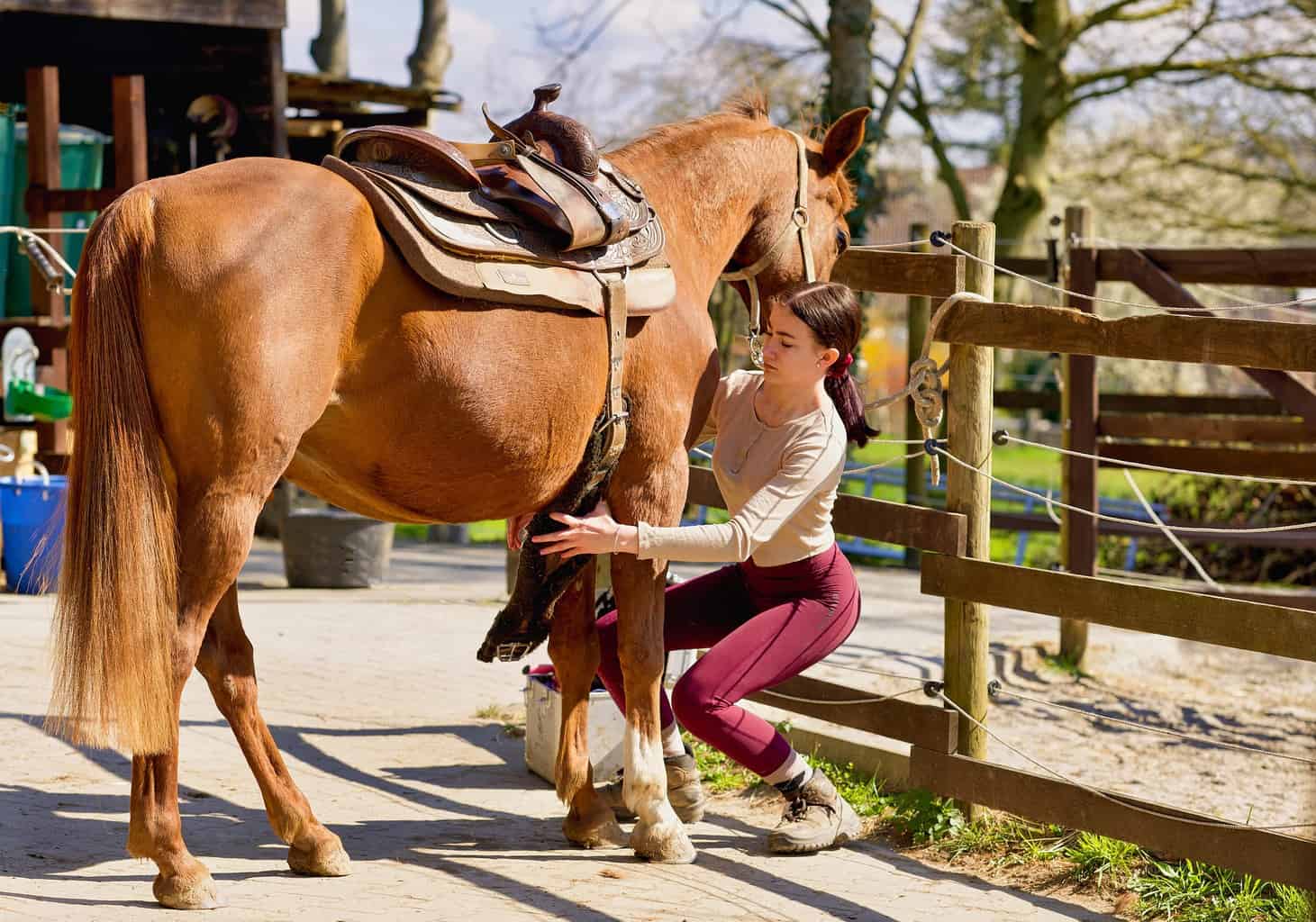
Choosing a saddle combines the technical features, preferences, comfort, and sports requirements.
Decide on the Type of Riding You Do
If you are riding in a dressage test, you won’t ride in a Western roping saddle. Likewise, cattle work would be better done from a ranch saddle and not in a jumping saddle.
Few saddles are designed to be truly all-purpose. The English GP or general-purpose saddle is the closest to this in that you can trail ride, do lower level dressage, and jump in it. While you won’t be able to rope steers from an English saddle, you can attach a saddlebag for trail rides and do essential ranch work.
Your Comfort
If you spend an hour a day in a saddle for a riding lesson, you can perhaps put up with a slightly uncomfortable saddle. However, when you’re doing a cross-country trail ride and spend about six to eight hours a day in the saddle over rough terrain, you want an ultra-comfortable saddle.
Work Within Your Abilities
Not all of us are the same. Some of us are otherwise abled, and we may struggle to lift and swing a heavier Western saddle onto a 15-hand horse. If you are differently abled, you need to get a saddle you can easily handle on your own.
Injuries can also limit what type of saddle you can ride in. Perhaps you’re shorter in one leg due to a hip operation, or you may have a curved spine. You would then need to find a suitable and comfortable saddle for you.
Think Long Term
A good-quality leather saddle can last for generations if properly cared for and well-stored. I was thrilled when my son inherited my grandfather’s ranch saddle and could still use it. Today, many saddles are part or fully synthetic. While these saddles are more breathable and lightweight, they have yet to prove their longevity.
Best You Can Afford
Finally, saddles aren’t cheap. If you find a cheap saddle, there may be a reason. Perhaps it won’t see out for more than a year or two. While this is fine if you only ride once a week, a good-quality saddle is worth the cost for someone who rides daily.
Buying Guide for Horse Saddles
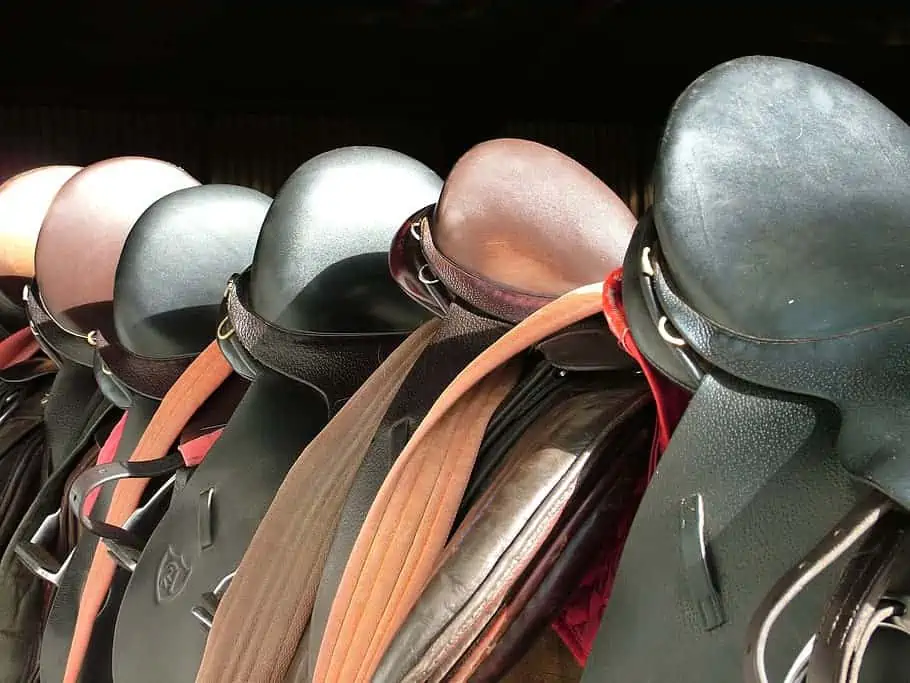
I’ve chosen the best saddles per type of horse riding you do, and I’ve also looked at the best budget saddles for those starting in riding. The following were the criteria I used, and these are important as simply choosing a pretty saddle isn’t a responsible choice.
1. Best in Type of Riding
The saddle you choose needs to be great for the type of riding you do. If you ride in more than one equestrian discipline, you need an all-purpose saddle that can work in different riding arenas.
As I mentioned, an English GP saddle is a good option when you’re starting unless you have your heart set on trail riding and ranch work. A good-quality general farm-style Western saddle is a great choice then.
2. Material Quality
The type of leather used to make a saddle will influence the quality of the saddle. Properly treated top-grain leather is a wise choice. Feel the quality of the leather. If it is hard and unyielding, your saddle’s leather will probably crack.
If you decide to go for a synthetic material saddle, rub over the fabric to check how it will hold up to friction. Is the fabric UV resistant, and what is the finishing like of the synthetic fabric? Thin material will probably rub through, so opt for a leather-type synthetic fabric that is thick, durable, and will last longer.
3. Craftsmanship and Quality
The craft of making a quality saddle isn’t something anyone can do. Look for a family-owned business or brand that’s been around for years and proven itself. Alternatively, a popular saddle with great reviews for its durability and manufacture will also do well.
One of my son’s first ranch saddles that he learned roping in was an unknown brand. The brand isn’t always an indication of quality. Instead, perform a visual inspection. Check all seams, and feel and test the leather quality EVERYWHERE on the saddle.
Turn back panels and check the underside of the saddle. If the saddle has an interchangeable gullet system, open this and check the finishing of the studs. Push and pull a little on the pommel and cantle areas, noting any movement.
4. Budget
While my son competes professionally, I know that the saddle isn’t the only expense for a horse rider. So the budget is a definite consideration. Cheap is never good quality, but having to sell a kidney to buy a saddle isn’t a great idea either. So budgeting is about balancing affordability with quality.
Best Horse Saddles Per Type
Best English General Purpose Saddle – Wintec 2000 GP with HART
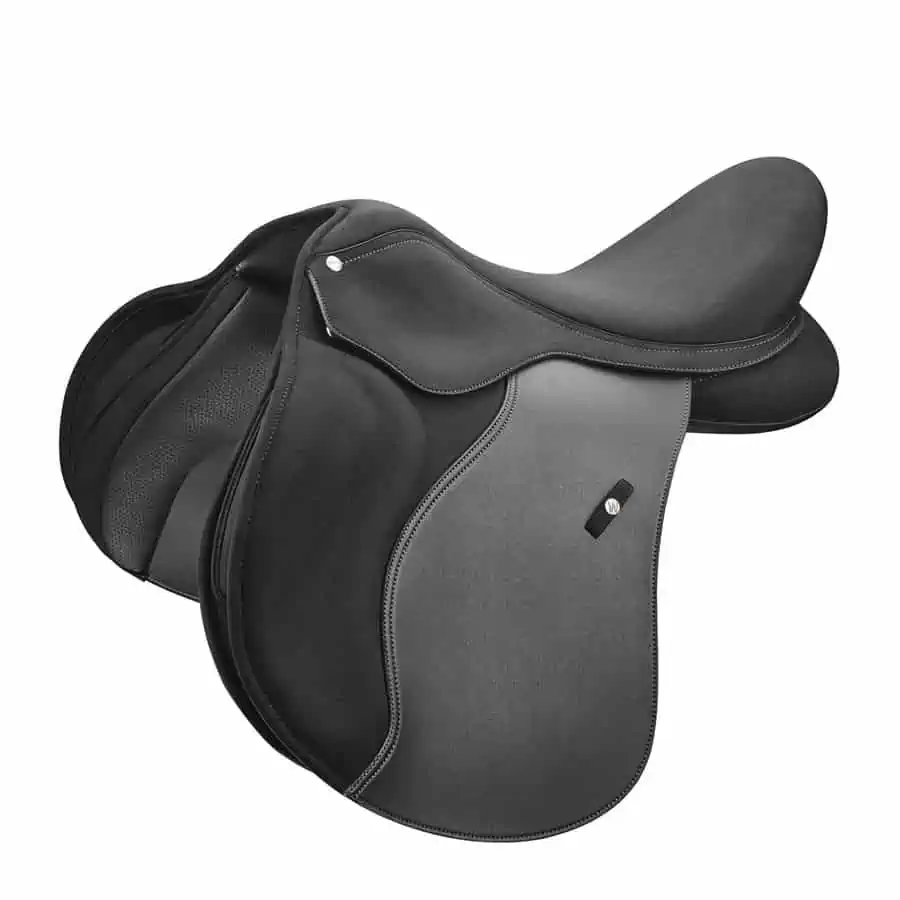
The Wintec 2000 All-Purpose Saddle with HART is a great all-rounder. My son and I have both ridden in it on a range of horses doing everything from jumping to dressage to trail riding and even a little herding work on the neighboring ranch.
The Wintec 2000 GP is also synthetic and lightweight, making it a quality saddle to start your riding career.
Pros
- Interchangeable gullet system for better fitment
- Adjustable knee blocks to create a secure seat
- Ergonomic and comfortable stirrup bar that doesn’t clump under the thigh
- Lightweight and soft seat
Cons
- Repairs can be costly as the saddles are imported from Australia
- Heavier riders may apply more pressure on the flexible gullet system than a fixed gullet that can’t flex
Best Western Ranch Saddle – Circle Y XP Dodge Cowhorse Ranch Saddle
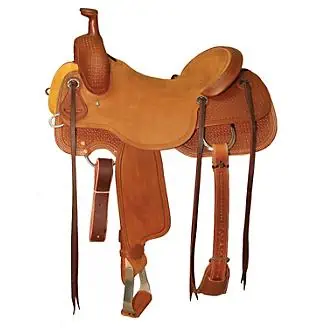
The Circle Y XP Dodge Cowhorse Ranch Saddle is ideal for ranch work. And made from genuine leather, it’s comfortable and fits most quarter horses.
Pros
- Hand-tooled for precision
- Aluminum stirrups for weight reduction and wider stirrup bars too
- Lifetime guaranteed tree
- Close-cut skirts for precision fit
Cons
- Heavy at 40 pounds, making it better suited to hard-working ranchers as opposed to pleasure riders
- Saddles often need to be ordered as handmade saddles take longer to produce
- The saddle is designed for quarter horses, so may not fit slender built horses
Best Trail Saddle – King Series Comfort Gaited Saddle
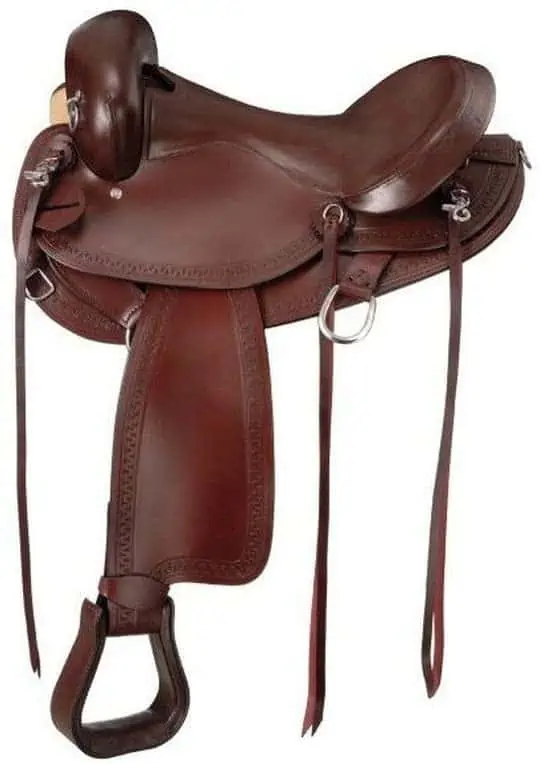
The King Series Comfort Gaited Saddle is not only excellent for long hours in the saddle, but it’s also ideally priced.
Pros
- Made from quality leather and neoprene skirts for added comfort
- Tough-1 quick change buckles for quality and security
- Leather strings and dee rings for securing packs when on the trail
Cons
- The saddle sizes seem to be slightly more snug than other 15 or 16 inch saddles, so size up
- It doesn’t have the typical deep seat of most Western saddles
Best Jumping Saddle – Henri de Rivel Cahill CC Saddle
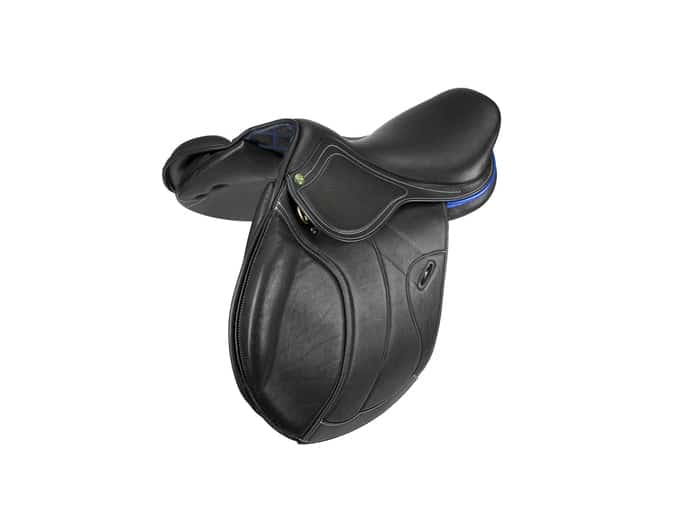
The Henri de Rivel Cahill CC Saddle is an ideal buy if you are starting on the jumping circuit. Satisfied riders commented that it looks and rides like a much more expensive saddle. This close-contact saddle isn’t as bulky as some other jumping saddles. It automatically “seats” the rider’s legs in the correct position for jumping.
Pros
- Lifetime warranty of saddle tree
- Signature stitching is eye-catching
- Molded knee pads and a deeper seat for security when jumping
- Adjustable gullet system to help with fitment
Cons
- Saddle comes with a medium gullet plate, which won’t fit all horses
- Imported, so repairs may be difficult
FAQs
Answer: There are many different saddle types, with variations in each type too. The top ten types of saddles are as follows:
• General-purpose saddle
• Dressage saddle
• Jumping saddle
• Hunting saddle (this isn’t for “real” hunting)
• Kids’ saddle
• Western saddle
• Sidesaddle
• Racing saddle
• Treeless saddle
• Stock saddle
Answer: While there are many types of saddles, the best saddle for your horse allows you to do the kind of riding you want while being comfortable for your horse.
Answer: A fairly decently priced Western saddle may cost around $800, while an English saddle may cost as much as several thousand dollars.
Answer: The saddle should firstly fit the horse. A horse can’t always tell us that a saddle is pinching or making them uncomfortable. While a rider can try to sit more comfortably in a saddle, a horse has no choice once the saddle is tightened.
Once the saddle fits the horse comfortably, the rider can choose the size of the seat, style of the saddle, and purpose according to what the rider needs.
Answer: It is not a sign of good quality when a saddle’s leather is thin and feels like cardboard or a cheap “leather” belt. Leather saddles should be made with thick leather that is soft and pliable so they can absorb leather oil and remain flexible over time.
With a synthetic saddle, be sure to check the UV rating of the saddle material and feel it to check whether it’s snag-resistant, pliable, and durable.
The Final Saddle
When you are thinking of buying a saddle, be sure to consider what type of saddle you need. The type of saddle is determined by the kind of riding you do. If you’re not entirely sure what riding discipline you’re most into and want to do a little bit of this and that, then a general-purpose saddle is a good investment.
Be sure to choose a comfortable saddle for both you and your horse, and you will be one step closer to achieving your riding dreams.
